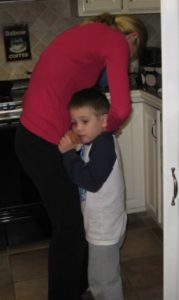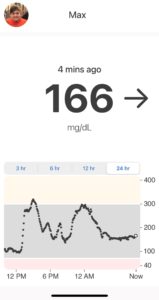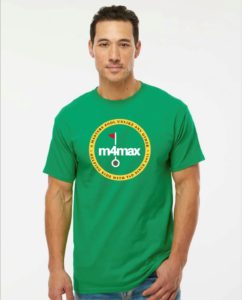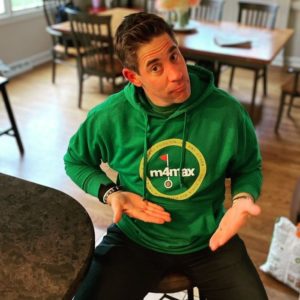Phew! Another Record Breaking M4Max in the Books First, thank you to all 3,100+ participants…
Let Me Tell You About Max
Let Me Tell You About Max
First, he needs a haircut. You can’t really tell in this picture because apparently it’s a crime for middle schoolers to go anywhere without a hoodie these days, but he currently looks like a sheepdog.
Also, his 17 year-old sister likes to dress him like an idiot, which he apparently indulges. And is that a gang symbol? Should I be concerned?
Second, today Max is 14, and he checks pretty much every box you’d expect an 8th grade boy in America to check: obsessed with sports, loves to hang out with his buddies in the neighborhood and play video games and driveway basketball and whatever game they invent that day, could watch Tik Tok for hours if we let him, lives in sweatpants. He’s genuinely a great kid, and he’s got such a great sense of humor. A little over a decade ago, though, I would have had a hard time imagining just how “normal” his life could seem. Here’s a picture of Max when he was 3, with my wife administering an insulin shot in the back of his arm.

No wonder the kid is now tough as nails.
For years we had to do this 4 times a day, in addition to pricking his finger to test his blood sugar at least a dozen times a day (including twice in the middle of the night). Imagine being 3 years old and having your parents grab you a few times a day to jab a needle in your arm or leg. Yeesh.
Today Max wears a pretty high-tech insulin pump, as well as a CGM, or Continuous Glucose Monitor. The CGM reads his blood sugar in near real time and sends it to my phone, my wife’s phone, and it talks to Max’ insulin pump. Here’s the snapshot of Max’ blood sugar over the past 24 hours; to us, these numbers look fantastic. But compared to someone without Type 1 Diabetes, Max’ blood sugar readings are a Richter scale (my blood sugar and yours – assuming you don’t have T1D – rarely deviate outside of 95-105).
The technology keeps getting better, but we’re still a long way from not having Max’ blood sugar numbers at the forefront of our mind at all times.
When you’re diagnosed with Type 1 Diabetes it’s scary. Unlike Type 2 Diabetes, which can be controlled and even reversed through exercise and diet (and is far more common; 95% of all diabetes is Type 2), the pancreas of a Type 1 diabetic makes no insulin. Without vigilant attention to blood sugar highs and dangerous lows – highs and lows that are influenced by myriad factors like stress, hormones, exercise, what and when and how much you eat, etc. – all sorts of terrible things can happen that I hate to even think about. And most people are diagnosed with Type 1 Diabetes when they’re young, hence the reason it’s often referred to as Juvenile Diabetes. As you might imagine, then, when you’re young and diagnosed with a life-threatening disease that requires you to wear a pump or inject yourself with insulin every time you eat, you feel different and self-conscious and alone. With that in mind, an since you’ve come this far, give me one more minute to tell you about the incredible, unstoppable Ainsley Fraser…
M4Max is for the Ainsley Fraser’s of the World
Currently a senior at Beaumont School in Cleveland Heights, OH, just a few years ago Ainsley Fraser’s world was flipped upside down after her Type 1 Diabetes diagnosis. Here are Ainsley’s words, from her college entrance essay:
Finally released from my three-day sentence in the hospital, I was sent back to sophomore year high school equipped with all I needed to know about my pesky pancreas. Afraid of stares and questions, I realized lunch at school quickly became synonymous with trips to the nurse to give myself insulin before I could eat. My teachers and friends were just as shocked about the diagnosis as my family and me. Although everyone around me offered their support, I was in need of someone who could truly relate to the struggle I was recently pushed into. I couldn’t comprehend that this disease now governed my thoughts. This storm now pummeled all normalcy in my life. Starting to notice how heavy the burden of diabetes was becoming on my shoulders, my mom began to look for ways for me to connect with other diabetics my age. While skimming through a flyer from the hospital, which we had been sent home with, her gaze was caught by a line about a camp for kids with type one diabetes.
Can I just pause for a second and say: in case you can’t fully comprehended how your participation in our little Masters pool can change the trajectory of someone’s life, well, buckle up for the next part of Ainsley’s college essay.
A little over a year later, I am surrounded by a group of eight year old girls with the same diagnosis. They know me as their counselor, and I know them as my campers. Laughter and the crackle of fire fill our ears as we wait with anticipation for our s’mores to reach the perfect golden brown. “Have you all bolused?” I ask them to make sure they have taken their insulin. One girl raises her hand to say she hasn’t yet. Together, she and I walk over to the medication station and prep her insulin pen. I help her count the carbs she plans on eating and calculate how much insulin she should give. The resident endocrinologist approves her dosage. With ease, she gives herself the shot. She hands the insulin pen back to me and races back to her friends.
Ainsley at her happy place, Camp Ho Mita Koda.
Thinking back to the frightened girl I was in the hospital, I wish I could go back in time to show her this snapshot of diabetes camp. How someone half her age doesn’t even think twice about a wimpy needle she has to stab herself with. This is just one of the astounding memories my diagnosis has given me. This past summer I spent many of my days volunteering as a counselor at a camp for kids with type one diabetes. Becoming a role model for these kids, a humbling experience, completely flipped my perspective of diabetes. Watching how strong they were: giving themselves insulin injections and changing their own insulin pumps, was truly inspiring. When I am at Camp Ho Mita Koda, I am grateful for a diagnosis that I thought would ruin my life. Sitting in that hospital bed, I never would have known that that was the start of the best part of my life
Ainsley’s college essay landed her a college scholarship, and this Fall she’ll begin attending Ursuline College of Nursing with a focus in – you guessed it – pediatrics and diabetic care.
I’ve never met Ainsley, but she’s already a rock star in my book. Ainsley’s father, who is participating in the 2022 M4Max Challenge and shared Ainsley’s essay with me with her permission, said in an email yesterday, “I sincerely believe that if it were not for Camp Ho Mita Koda, our daughter would not be the amazing person she is today.”
Amen.
Whether you’ve entered one team for $20, or donated $2,500, you’re helping change the lives of the Ainsley’s of the world. To date, the M4Max pool has raised nearly half a million dollars for CHMK, and we’ve become its #1 fundraiser annually and a critical source of funding. If you’ve been here since the beginning, or if you’ve just stumbled upon our little contest for the first time this year, you have my sincere thanks.
If you’ve read this far, I appreciate you indulging me. But now it’s time to get back to the ridiculous memes and Dad jokes. As I write this, Jim is rehearsing another majestic Ode to Augusta, Verne is excitedly following a trail of hard candy to the tower at 16, Cam Smith is tuning up his swing out in the woods*, and one of you is about to be $20,000 richer.
It’s Sunday at the Masters. Thank you for participating in the 2022 M4Max, and if you’re watching today with a family member or friend who has chance down the stretch to grab 20 large, keep a defibrillator on standby.
Best,
Chris (Max’ proud father and Ainsley’s new #1 fan)
*Lesser men warm up on the driving range. Cam Smith fells a few dozen Georgia Pines.

Do More Good: Get Your M4Max Gear While It’s Hot!
Get your Christmas shopping done early, and thanks for supporting another awesome M4Max Challenge!






